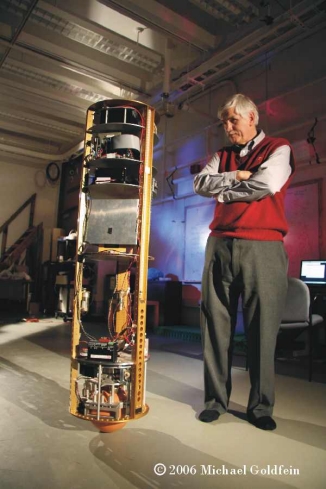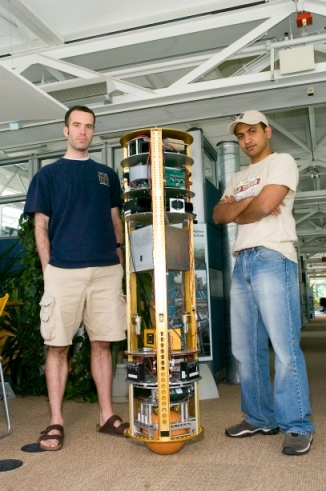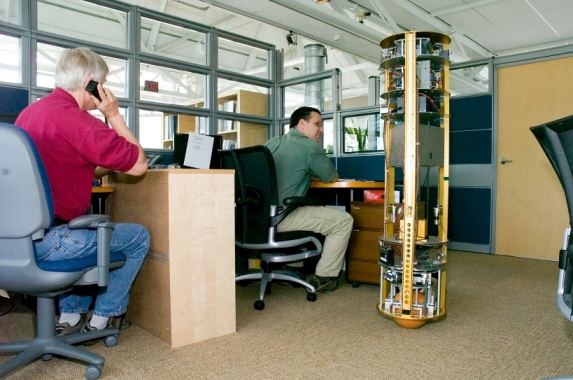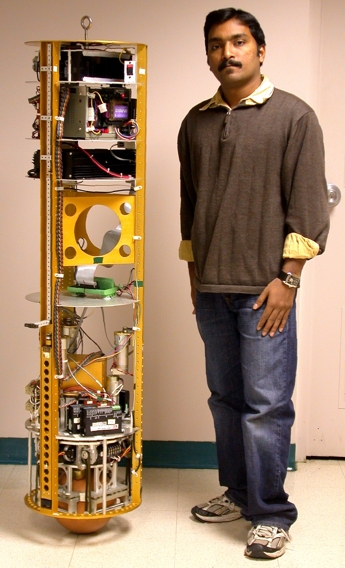Dynamically-Stable Mobile Robots in Human Environments
Ankit Bhatia, Carl Curren, Mark Dudley, Jodi Forlizzi, Jared Goerner, Ralph Hollis, George Kantor, Kalicharan Karthikeyan, Byungjun Kim, Masaaki Kumagai, Tom Lauwers, Jun Xian Leong, Anish Mampetta, Umashankar Nagarajan, Suresh Nidhiry, Kenneth Payson, Kathryn Rivard, Eric Schearer, Michael Shomin, Bhaskar Vaidya, and Luo (Jack) Yi
Introduction
In recent years, there has been a growing realization that much of the success in the application of industrial robots to manufacturing might also become true for mobile robots in the service sector. In particular, robots that could serve as personal assistants for people---especially those who are elderly or physically challenged---are moving from fantasy to the realm of the possible. The rapid progress in computing and the growing body of knowledge in robotics are leading us toward a goal which could have many benefits for society.
The human-machine interface is a key area of interest, particularly in the physical interaction between the robot and person. Industrial robot arms and research mobile robots are position-controlled (rather than force-controlled) devices which are heavy and clumsy. Their motions cannot readily accommodate to an environment made for people. Mobile robots that locomote with wheeled drives are slow and awkward, with wide bases providing static stability. What is needed is an entirely different approach to locomotion: mobile robots that are safe; dynamically agile and capable of graceful motion; slender enough to easily maneuver in cluttered, peopled environments; and which readily yield when pushed around. Intelligent machines of this sort can only be achieved with dynamic stability.
Our research goal is to gain a deeper understanding of how such dynamic agility can be achieved in mobile machines interacting with people and operating in normal home and workplace environments. We are developing novel dynamically-stable rolling machine and walking machine research platforms to study this issue. We will evaluate the efficacy of this type of dynamic locomotion in the context of human environments.
Significant insights will be gained from this research toward producing agile motive platforms which in the future could be combined with the research community's ongoing work in perception, navigation, and cognition, to yield truly capable intelligent mobile robots for use in physical contact with people. Such robots could provide many useful services, especially for the elderly or physically challenged, in their everyday work and home environments. Many other uses such as entry into hostile environments, rescue in buildings, and surveillance to safeguard people or property can be envisioned.
Ballbot Research Platform
We have begun our research program by developing a person-sized mobile robot that has only a single spherical wheel. Our preliminary experiments with this platform are described in the papers "One is Enough!" and "A Dynamically Stable Single-Wheeled Mobile Robot with Inverse Mouse-Ball Drive." A Scientific American article, "Ballbots," published in the October 2006 issue provides a general discussion. More recent technical publications include
- "Trajectory Planning and Control of an Underactuated Dynamically Stable Single Spherical Wheeled Mobile Robot"
- "State Transition, Balancing, Station Keeping, and Yaw Control for a Dynamically Stable Single Spherical Wheel Mobile Robot"
- "Human-Robot Physical Interaction with Dynamically Stable Mobile Robots"
- "Dynamic Constraint-based Optimal Shape Trajectory Planner for Shape-Accelerated Underactuated Balancing Systems"
- "Hybrid Control for Navigation of Shape-Accelerated Underactuated Balancing Systems"
- "Integrated Planning and Control for Graceful Navigation of Shape-Accelerated Underactuated Balancing Mobile Robots"
- "Planning in High-dimensional Shape Space for a Single-wheeled
Balancing Mobile Robot with Arms"
Carnegie Mellon University press release, August 9, 2006.
Photos and Videos
Ballbot balancing in the CMU motion capture lab, with Ralph Hollis looking on. (Photo copyright Michael Goldfein, used with permission.)
Graduate students Eric Schearer (left) and Anish Mampetta (right) with Ballbot, photographed in the CMU Intelligent Workplace.
Ralph Hollis (left) and George Kantor (right) with Ballbot, photographed in the CMU Intelligent Workplace.
Umashankar Nagarajan and Ballbot
You may view videos of:
- Response to a disturbance (2005)
- Point-to-point motion (2006)
- Carnegie Science Center RoboWorld Display (2009)
- Fast motions (2010)
- Fast maneuvers (2010)
Ballbots Around the World
These days, many people around the world are intrigued by the notion of ballbots. Here are some links to media videos about our Ballbot project:
- Ballbot & Ralph Hollis on Daily Planet
- Ballbot - ROBORAMA.info
- Ballbot- Discovery Channel Feature
- The Gadget Show: Web TV 66 Nokia N900, Ipad & Ballbot
- Ballbot on Rocketboom (just for fun)
Here are some liks to other projects and videos:
- A Robot That Balances on a Ball by Masaaki Kumagai, Tohoku Gakuin University
- A robot balancing on a ball by Masaaki Kumagai , Tohoku Gakuin University
- NXT Ballbot : Simulation with MATLAB/Simulink Lego ballbot
- NXT Ballbot : Self-Balancing Robot On A Ball Lego ballbot
- ballbot Another Lego ballbot
- The 2009 Ballbot Project in University of Adelaide, Australia
-
Rezero - Ballbot performance and interaction from ETH in Zurich



